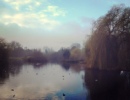
22 August 2018
NCRA contacted a number of officers and councillers from Bexley to ask why trees were being felled at Footscray Meadows. We have to thank Phillip Louis, Bexley's Trees and Woodland officer for the following reply :
Firstly, it's wonderful to see that
people are still passionate about the green spaces where they live and I
understand that trees are an especially emotive subject, as such I hope
that my following explanation will put your mind at ease.
As you
may or may not have been aware in recent years the 'islands' within
Footscray meadows Lake have begun capsizing, gradually reducing the
habitat for swans and other water fowl, creating additional issues to
the hydro-dynamics (how the water flows) of the lake and becoming litter
traps.
There are several reasons for the islands
capsizing which include adjustments to water levels and hydro-dynamics
within the lake since the 5 arches bridge and weir were repaired/
rebuilt (in the early 2000's), the vegetation on the islands becoming
taller and therefore increasing their 'wind sail factor' (wind catches
them more) which is further compounded by multi directional wind and
relatively open grass plains allowing the wind to effect the islands
directly.
Ordinarily a trees root system is sufficient prevent
uprooting from wind, however the willows on the island are shallow
rooted and due to the depth of the lake are unable to gain any purchase
(currently rooting in silt build up), resulting in the loss of islands
that we have experienced already.
It is for that reason that
under consultation with Local Ornithological experts , the Friends of
the Footscray Meadows conservation officer and the London Borough of
Bexley's Flood Risk Management officer and the conservation officer it
was deemed that my solution to the long term and irreversible loss of
habitat for the swans and other water fowl is the best option. With this
time of year selected to mitigate the impact on the wildlife.
The
vegetation on the lake (willows and some poplar) are very responsive to
the traditional management style of coppicing and by carrying out this
work cyclically (every 6 -12 years) it will minimise the potential for
the islands to either submerge under the vegetative weight or capsize.
It is highly likely that by late spring there should be regrowth from
the coppice stools.
I understand that it may look like a dramatic
change in the landscape, but this is temporary whereas the complete
loss of the islands would be permanent.


